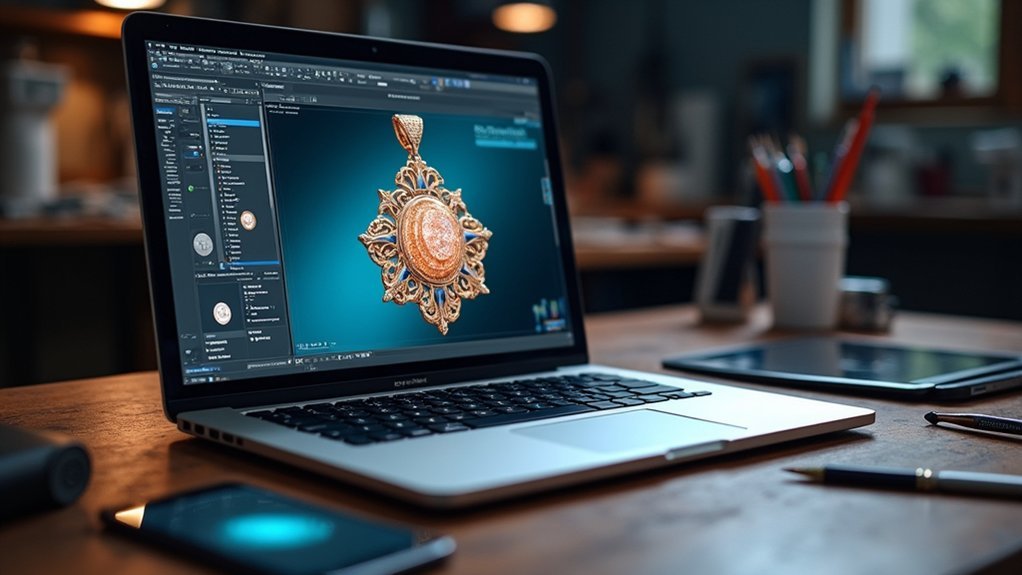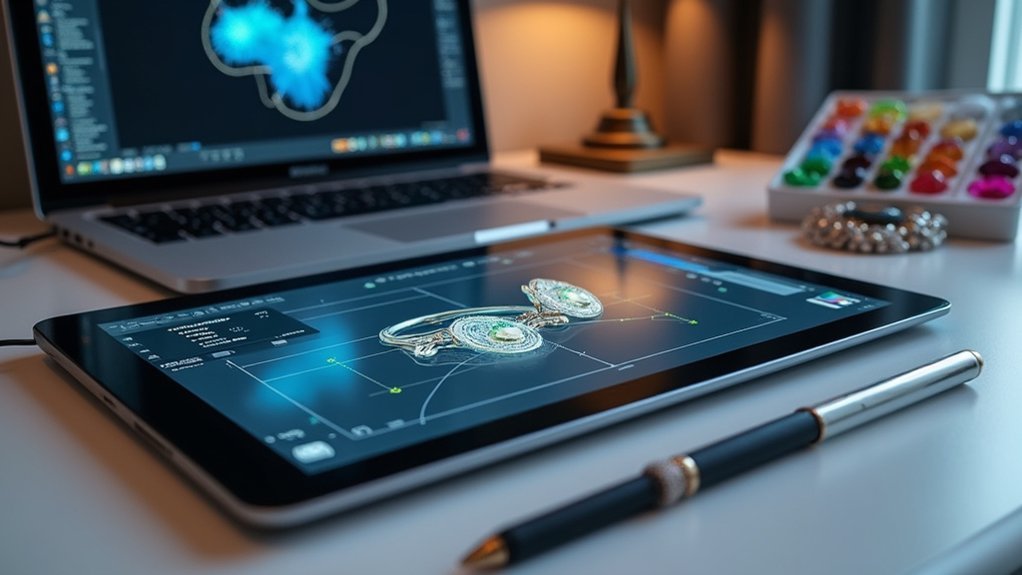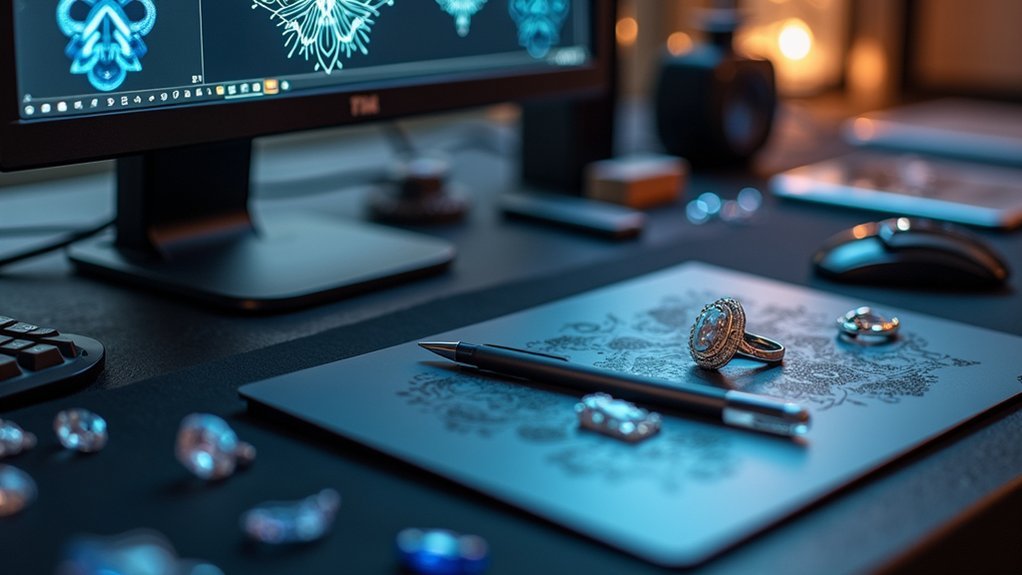You’ll need CAD software like Rhinoceros 3D ($995) or MatrixGold ($5,995) for professional jewelry design, offering precise 3D modeling and parametric capabilities. Beginners can start with free tools like TinkerCAD or FreeCAD before investing in specialized platforms. ZBrush ($895) excels at organic sculpting, while Fusion 360 ($495/year) provides cloud-based collaboration. Consider essential plugins like RhinoJewel for enhanced functionality. Your choice depends on budget, experience level, and specific design requirements. The thorough guide below reveals how to optimize your digital jewelry workflow.
CAD Software Fundamentals for Jewelry Design

Revolution has transformed the jewelry design landscape through Computer-Aided Design (CAD) software, which enables you to create precise, detailed prototypes that would be nearly impossible to achieve through traditional hand-drawing methods.
Modern jewelry design software offers specialized CAD tools tailored for intricate designs, with Rhino leading the field alongside MatrixGold and ZBrush.
Industry-leading CAD platforms like Rhino, MatrixGold, and ZBrush deliver precision-engineered tools specifically designed for complex jewelry creation and detailed artisanal work.
You’ll find these platforms provide essential 3D modeling capabilities with jewelry-specific features like parametric modeling for precise measurements and digital sculpting for organic forms.
Whether you’re developing complex settings or creating flowing curves, these tools facilitate rapid prototyping and seamless collaboration between designers, manufacturers, and clients.
The software streamlines your workflow from concept to production while reducing errors and material waste throughout the design process.
Professional-Grade Design Platforms and Features
When selecting professional-grade design platforms, you’ll discover that each software offers distinct advantages tailored to different aspects of jewelry creation.
These advanced parametric modeling capabilities enable you to develop intricate designs with high precision and efficiency.
Consider these leading CAD software options:
- MatrixGold ($5,995) – Combines Rhinoceros 3D functionality with specialized jewelry-specific tools for complex enterprise projects
- Rhinoceros 3D ($995) – Features accurate NURBS geometry modeling and real-time visualization for detailed prototypes
- ZBrush ($895) – Excels in polygonal modeling for organic designs mimicking traditional craftsmanship
- Fusion 360 ($495/year) – Offers cloud-based collaboration for custom commissions and scalable product lines
Each platform addresses specific workflow needs, from individual artisans creating unique pieces to large enterprises managing extensive collections.
Entry-Level Software Options for Beginners

Professional CAD platforms offer powerful capabilities, but they can overwhelm newcomers with steep learning curves and substantial costs.
Entry-level software provides accessible alternatives for beginners entering jewelry creation. TinkerCAD’s browser-based platform features drag-and-drop functionality, letting you create basic jewelry designs without prior experience.
JewelCAD delivers an intuitive interface specifically for jewelry design software applications, accommodating both novices and experts.
Shapr3D offers a user-friendly experience on iPad, perfect for sketching customized jewelry designs while mobile.
FreeCAD stands out as open-source software, providing parametric modeling flexibility for scalable projects.
Gravotech combines CAD/CAM functionalities for precious metal engraving and cutting, giving entry-level users an accessible starting point for their jewelry design journey.
Advanced Sculpting and Modeling Tools
As your jewelry design skills advance, sophisticated sculpting and modeling tools reveal creative possibilities that basic CAD software can’t match.
Advanced sculpting tools unlock creative potential that standard CAD programs simply cannot deliver for sophisticated jewelry designs.
These advanced capabilities transform how you approach intricate designs, especially when creating organic shapes that demand precision and efficiency.
Professional sculpting tools offer distinct advantages for jewelry design:
- ZBrush – Delivers extensive polygonal modeling for traditional craftsmanship-style details
- T-Splines for Rhino – Enhances surface modeling for complex organic forms
- Mudbox – Specializes in detailed texture painting and finishing touches
- Blender – Provides thorough sculpting, rendering, and 3D printing preparation
This modeling software category bridges artistic vision with technical requirements.
You’ll find these tools excel at creating complex geometries while maintaining the precision necessary for manufacturing.
Whether you’re developing avant-garde pieces or refining traditional designs, advanced sculpting platforms offer the creative possibilities needed for professional jewelry development.
Industry-Specific Jewelry Design Solutions

While general 3D modeling software provides foundational capabilities, industry-specific jewelry design solutions deliver specialized tools that address the unique challenges professional jewelers face daily.
MatrixGold ($5,995) integrates seamlessly with Rhinoceros, offering advanced functionalities including parametric design capabilities and thorough customization features. You’ll benefit from its dynamic command interface and professional render studio for stunning visualizations.
3Design excels in rapid concept development with its user-friendly interface, making it accessible for both beginners and seasoned professionals.
Jewelry CAD Dream ($5,850) delivers robust parametric modeling and advanced texturing tools specifically engineered for jewelry applications.
These industry-specific jewelry design software solutions streamline your workflow while enabling precise jewelry design that meets professional standards and client expectations.
3D Printing Integration and Prototyping
Once you’ve created your digital designs using specialized jewelry software, 3D printing technology transforms your virtual concepts into tangible prototypes within hours rather than weeks.
High-resolution printers like the Formlabs Form 3 deliver professional-quality physical models that capture intricate details essential for jewelry design.
CAD software integration enables seamless shifts from digital designs to printed prototypes, minimizing errors and material waste.
This workflow supports rapid iterations and enhances creative exploration through risk-free experimentation.
Your 3D printing options include:
- In-house printers for immediate control and frequent prototyping
- Professional services like Shapeways for cost-effective outsourcing
- High-resolution models that showcase fine textures and details
- Multiple material testing to evaluate design variations quickly
This technology accelerates your entire design process, allowing you to refine concepts efficiently before committing to expensive production materials.
Rendering and Visualization Software

When your digital jewelry design reaches completion, rendering and visualization software like KeyShot and V-Ray transforms it into stunning photorealistic images that captivate clients and elevate your marketing efforts.
These powerful tools integrate seamlessly with CAD software including Rhino and Fusion 360, creating an efficient workflow from conception to presentation.
You’ll access advanced features like customizable lighting, textures, and backgrounds that showcase your jewelry designs’ intricate details and finishes.
Real-time visualization capabilities let you make instant adjustments and immediately see their effects, enhancing both efficiency and creative exploration.
This technology dramatically reduces your need for physical prototypes during initial client presentations.
You can present concepts in visually compelling ways that help clients envision the final product, streamlining your design process while maintaining professional presentation standards.
Budget Considerations and Pricing Models
Before diving into specific software features, you’ll need to establish a realistic budget that aligns with your jewelry design goals and business requirements.
Jewelry CAD software pricing models vary dramatically, making budget considerations essential for smart investment decisions.
Smart budget planning prevents costly software mistakes and ensures your jewelry CAD investment matches your actual design needs and business goals.
Your cost-effective solutions include:
- Free tools like Blender and FreeCAD for experimentation
- Subscription models such as Fusion 360 at $495 annually
- Professional software like MatrixGold at $5,995 for advanced features
- Premium options including 3Design at $6,950 for extensive design capabilities
Free tools offer excellent starting points, while subscription models provide flexibility without large upfront costs.
Professional software delivers enhanced workflows that justify higher investments through increased productivity.
Consider your current skill level, project complexity, and revenue potential when evaluating pricing models.
Essential Plugins and Add-Ons for Enhanced Functionality

You’ll find that strategic plugin investments can dramatically expand your design capabilities without requiring entirely new software platforms.
Popular options like RhinoJewel and Grasshopper3D enhance Rhinoceros with parametric design features, while specialized tools like Clayoo bring organic sculpting capabilities for under $1,000.
When evaluating these add-ons, you’re looking at cost-benefit scenarios where a $1,000 plugin might deliver functionality that would otherwise require a $6,000 standalone solution.
Popular Plugin Options
Several powerful plugins can transform your basic CAD software into a specialized jewelry design powerhouse.
These jewelry design software extensions provide advanced customization features that’ll elevate your creative capabilities beyond standard CAD limitations.
Here are the top plugin options you should consider:
- MatrixGold – Premium parametric engine for Rhinoceros at $5,995, offering dynamic commands for professional jewelers.
- RhinoJewel – Automated gemstone insertion with specialized jewelry-focused tools.
- Clayoo – Under $1,000 sculpting capabilities module for intricate organic designs.
- 2Shapes – Advanced customization options with automated design features.
CounterSketch serves as an excellent client-facing add-on for $5,000, simplifying the customization process.
These powerful tools integrate seamlessly with your existing workflow, enabling sophisticated 3D printing preparation and complex geometry creation that traditional CAD software can’t match.
Cost-Benefit Analysis
When evaluating jewelry design plugins, you’ll need to weigh their substantial upfront costs against the long-term productivity gains they deliver.
MatrixGold ($5,995) transforms your workflow and productivity through advanced parametric modeling specifically for professional jewelry creation. CounterSketch ($5,000) provides a user-friendly interface that streamlines custom jewelry customization processes.
For cost-effective options, Clayoo (under $1,000) enables intricate jewelry sculpting with organic shapes, while Panther3D costs one-third of extensive alternatives yet delivers robust design capabilities.
Your investment depends on specific needs. High-volume studios benefit from MatrixGold’s technical drawings and rendering features, while smaller operations might prioritize Clayoo’s affordability.
Consider how each tool enhances your current jewelry design software options and whether the productivity improvements justify the initial expense for your professional jewelry business.
Workflow Optimization and Software Selection Criteria
While the abundance of digital design tools offers exciting possibilities for jewelry creation, choosing the right software and optimizing your workflow requires careful consideration of several key factors.
Start by evaluating these essential software selection criteria:
- Geometry compatibility – Solid modelers excel with geometric shapes, while polygonal modelers handle organic designs better.
- Budget alignment – Options range from free tools like TinkerCAD to professional software exceeding $5,000.
- Learning curve – Prioritize user-friendly interfaces for smooth workflow optimization.
- Advanced features – Look for automatic gemstone insertion, intuitive sculpting, and advanced customization capabilities.
Consider compatibility with prototyping technologies like 3D printing and laser cutting to guarantee seamless integration throughout your design process.
The right jewelry design software streamlines efficiency and enhances creative output.
Frequently Asked Questions
What Software to Use for Jewellery Design?
You’ll want Rhino for versatility and affordability, MatrixGold for professional parametric features, or 3Design for intricate detailing. TinkerCAD works if you’re starting out, while ZBrush excels at organic, artistic designs.
What Apps Do Jewellery Designers Use?
You’ll use professional apps like Rhino, MatrixGold, and 3DESIGN for advanced jewelry modeling. If you’re starting out, TinkerCAD works perfectly. For detailed sculpting, you’ll want ZBrush or Blender, plus KeyShot for realistic renderings.
What CAD Do Jewelers Use?
You’ll find most jewelers use Rhino for its precise NURBS modeling at $995, while professionals often choose MatrixGold at $5,995 for advanced parametric tools, or ZBrush for detailed sculpting work.
Is Autocad Good for Jewellery Design?
You’ll find AutoCAD isn’t ideal for jewelry design because it lacks specialized tools like gem setting features and parametric modeling. You’d need additional plugins or dedicated jewelry CAD software for better results.
In Summary
You’ve now got the roadmap to transform your jewelry design process with the right digital tools. Whether you’re starting with entry-level software or investing in professional-grade platforms, remember that your choice should align with your current skills and future goals. Don’t rush into expensive solutions—start with what fits your budget and workflow. As you grow, you’ll naturally graduate to more advanced tools that’ll elevate your creative possibilities.





Leave a Reply